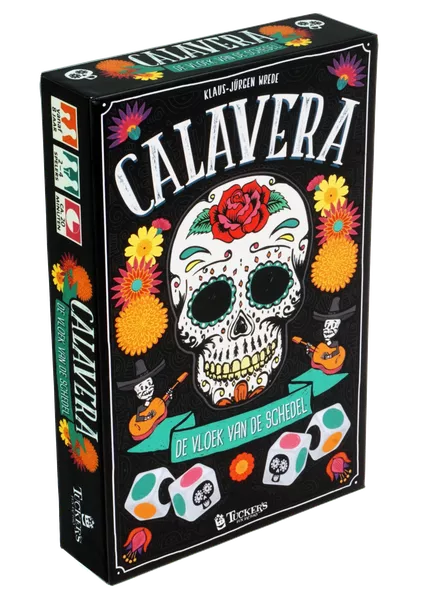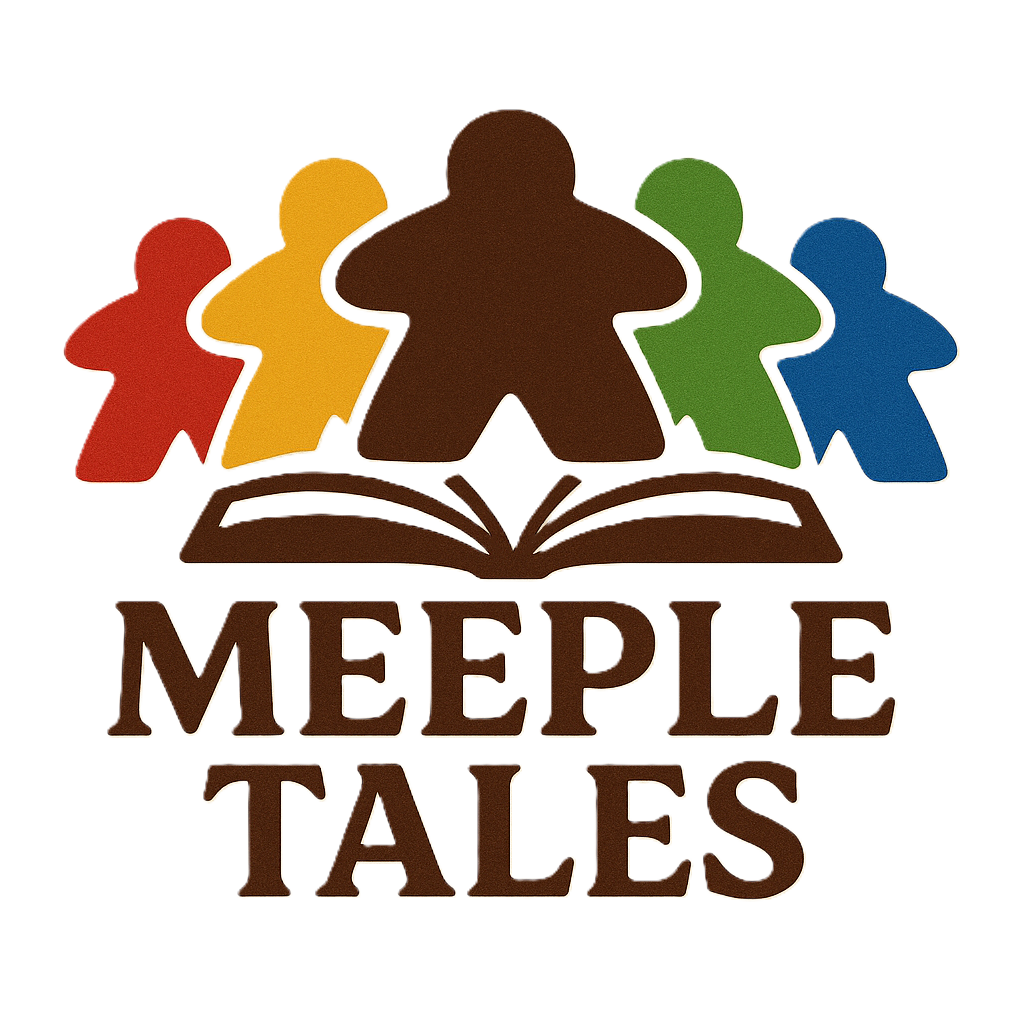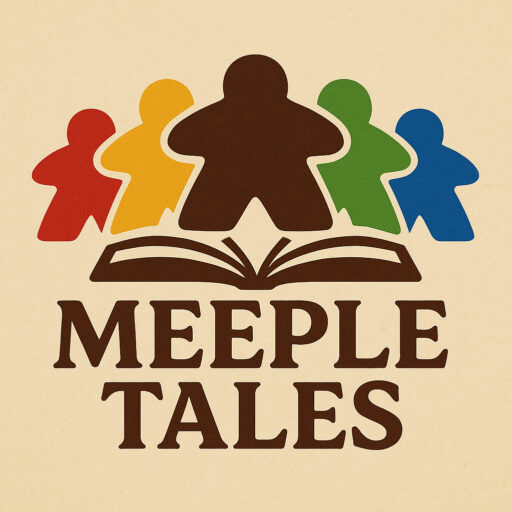Aantal spelers: 2-4
Speelduur: 20 minuten
Leeftijd: Vanaf 8 jaar
Auteur: Klaus-Jürgen Wrede
Uitgever: Tucker’s Fun Factory
Jaar: 2019


Dit is een herpublicatie van een review die ik eerder schreef voor bordspelwereld.nl
Roll & Writes. Wat zal ik er eens van zeggen. Het is als een soort liefde waar je niet met en niet zonder mee kan. Een soort haat/liefde verhouding. Als je me er over een vertelt vind ik ze bijna per definitie stom. Bij voorbaat. Nou ja, vond. Want hoewel luttele uitgevers vinden dat Roll& Writes hun beste tijd hebben gehad en die markt verzadigd begint te raken, krijgt die markt nu pas een beetje ruimte in mijn hoofd. Want eigenlijk zijn ze best leuk, maar voelt het een beetje als not done om zulke simplistische spelletjes tot je favorieten te rekenen. Dat zegt toch wat over je smaak, nietwaar?
Toch begin ik te ontdekken dat er in de wildgroei van Roll & Write spellen best een paar leuke zitten waarvan je kan zeggen dat er wat diepgang, interactie en mooi art work zit. Dat laatste is vind ik van onderschatte waarde. Persoonlijk heb ik, hoewel ook vermakelijk, alle variaties van dobbelstenen in primaire kleuren waar bij je de (som van de) getallen moet wegstrepen wel gezien. Maar Spuit 11 hier maakte deze week kennis met een “oldie” die het spelen van een Roll & Write een stuk mooier, aangenamer, interactiever en leuker maakt: Calavera.
Voor veel van jullie zal dit misschien een “dat wisten wij toch al lang?”- review zijn. Dan kun je hem skippen. Ook ik wist echt al wel jaren van Calavera. Vooral aangetrokken door het prachtige kleine doosje met dito art work, waarbij je wat normaal de onderkant is als een laatje uit zijn omhulsel schuift, had ik dit spel al luttele keren in mijn handen. De kwaliteit en art work zijn simpelweg prachtig. Maar door het vooroordeel “Ik heb al genoeg van deze meuk”, legde ik hem dan altijd terug. Zo van: Ik ben sterk en laat me niet door het art work verleiden, zo goed kan het niet zijn. Little did I know…
Lange intro voor een klein spel, ik weet het. Ik denk dat ik stiekem schuldgevoel aan het afkopen ben ofzo. Want ik vind deze Roll& Write onderbelicht en hij verdient wat mij betreft een groter podium dan veel van zijn collega-spellen al hebben. Wellicht kan ik wat licht brengen in de dobbelduisternis waar ook andere spelers last van hebben en die net als ik nog overtuigd moeten worden.
In de basis voldoet dit spel aan wat je verwacht van een Roll & Write: Scoreblokje, dobbelstenen in primaire kleuren, en als basis: het afstrepen van getallen of patroontjes op dat formuliertje. Echter: in het geval van Calavera is er meer! And: Me Like!
We nemen de stappen even door, want die zijn vrij simpel:
Je gooit met de dobbelstenen en legt bij de worp de dobbelstenen weg die je wilt gebruiken om af te strepen. De dobbelstenen hebben een rode, blauwe, gele of groene kant (surprise surprise), of bevatten een schedel of een roos.
Je mag dit nog twee keer herhalen met een maximum van drie worpen, waarbij je eerder weggelegde dobbelstenen ook mag hergebruiken (tenzij je een schedel gooit, die gooi je niet overnieuw, kom ik op terug). Dit mag dus, maar hoeft niet.
Na drie keer werpen streep je het resultaat af op je blaadje.
Klinkt vrij simpel. Maar het venijn zit zoals men weet, altijd in de staart. Een Roll & Write valt of staat bij punt drie en Calavera weet zich hier met zijn mechanisme te onderscheiden van zijn alom geprezen collega-spellen.
In Calavera streep je op je formuliertje kleuren af. Je kiest welke kleur dobbelsteen je wilt wegstrepen en zet het aantal kruisjes zoveel als dat je dobbelstenen hebt gegooid in die kleur. Je zou verwachten dat hoe meer kruisjes je zet, hoe verder je komt, maar ook in dat staartje zit het spreekwoordelijke venijn. Want pas vanaf zes kruisjes gaan ze punten opleveren en na tien kruisjes nemen de punten weer af tot het punt dat het je zelfs minpunten op kan leveren. En je kan dus niet “zomaar” stoppen met het zetten van kruisjes in een bepaalde rij, dus dat kan knap lullig worden.
Het zit namenlijk zo:
Wanneer je een schedel gooit, leg je deze aan de kant en gooi je deze niet meer opnieuw. De schedel betekent dat je medespelers in jouw beurt óók een kleur moeten afkruisen. Of ze nou willen of niet. Ze mogen dan niet dezelfde kleur kiezen als jij en kunnen op die manier middels jouw worp met hun kruisjes in het minpunten gebied terecht komen omdat ze gedwongen worden een bepaalde kleur te kiezen. (Het kan dus interessant zijn om zelf niet voor de beste optie te gaan, maar genoegen te nemen met minder zodat je je tegenstanders de minpunten in dwingt!).
Bij de drie schedels is het zelfs zo dat jij zelf helemaal niets meer mag afkruisen. Je beurt stopt en alleen je tegenstanders mogen wat afkruisen. Overigens mogen zij onderling wél dezelfde kleur kiezen
Wel nu. Naast schedels hadden we ook nog rozen. Deze heb je nodig om jezelf te beschermen tegen minpunten. Wil je niet gedwongen worden tot minpunten, dan kun je er voor kiezen om rijen te bevriezen. Afhankelijk van het aantal kruisjes wat je al hebt moet je twee of drie rozen gooien in een beurt om een rij te kunnen bevriezen en op deze manier hier niet meer af te kunnen strepen. Je verzekert jezelf dan van de punten. Bovendien: Wanneer bij een speler alle rijen vol of bevroren zijn, stopt het spel! Bevriezen is dus noodzakelijk. Nog niet vermeld, maar waarschijnlijk wel verwacht: de speler met de meeste punten wint.
Calavera is hiermee naast een Roll & Write simpelweg ook een heel strategisch spelletje, waarbij je niet alleen solistisch bezig bent maar de tegenstander ook goed in de gaten moet houden. Wanneer je alleen voor je eigen punten gaat, kan je dit wel eens duur komen te staan en roll je jezelf zo de minpunten in en loop je bonussen mis. Je moet je simpelweg verhouden tot wat een ander doet. Dit wordt nog eens versterkt door die bonussen. Er zijn namelijk extra punten te verdienen wanneer je bij alle kleuren de drie, zes of negen kruisjes hebt verzamelt. Waarbij er natuurlijk meer prestatiebonus is voor degene die dit als eerste doet.
Het is verleidelijk om zo vaak mogelijk door te rollen om zo veel mogelijk kruisjes te hebben, zeker in het begin. Maar vaker gooien betekent ook: statistisch meer kans op drie schedels en dus het helpen van je tegenstanders in plaats van jezelf.
Hiermee ontstijgt dit spel echt de simpliciteit van veel andere Roll & Writes. Het is niet meer alleen een kwestie van geluk en wat de dobbelsteenworp je brengt, maar écht een kwestie van strategische keuzes. Nou is het bij meer Roll & Writes natuurlijk een kwestie van slim kiezen en de juiste keuzes, maar die zijn vaak alleen gerelateerd aan: “hoe krijg ik zelf de meeste punten?” In dit spel vraag je je veel meer af: Help ik mijn tegenstander hier niet mee? Moet ik mijn punten niet veilig stellen? Dobbel ik verder en neem ik risico (op drie schedels of minpunten)? Neem ik de meeste punten of neem ik genoegen met minder zodat ik mijn tegenstander kan pesten? Ga ik zo snel mogelijk voor véél punten in één kleur, of werk ik gestaag aan alle kleuren om de bonussen op te strijken, maar waardoor ik waarschijnlijk minder ver kom in de puntengebieden?
Zoals je hoort ben ik enthousiast. Het onderscheid en de diversiteit aan (gelaagdere) keuzes maakt dat ik deze Roll&Write een 7,5 geef. Dit omdat ik echt vind dat duidelijk moet zijn dat Calavera boven zijn soortgenoten uitstijgt. Dan is een zeven mij te min, hoewel dat wellicht ook kloppend is. Wanneer je zoals ik dat deed, nu nog steeds denkt, ik heb al genoeg, koop hem dan toch! Alleen al met het art work doe je jezelf een plezier en is het een visueel pareltje in je spellenkast. Zélfs wanneer je ‘m niet speelt.

Calavera
Players: 2-4
Time: 20 minutes
Age: 8+
Author: Klaus-Jürgen Wrede
Publisher: moses. Verlag GmbH
Year: 2019


Roll & Writes. What shall I say about it. It’s like a kind of love you can’t live with and can’t live without. A kind of love/hate relationship. If you tell me about one I find them stupid almost by definition. In advance. Well, thought. Because even though lithe publishers think Roll& Writes have had their day and that market is starting to get saturated, that market is only now getting a little space in my head. Because actually they are quite fun, but it feels a bit like not done to count such simplistic games among your favorites. That says something about your taste, doesn’t it?
Still, I am beginning to discover that in the proliferation of Roll & Write games there are quite a few nice ones that you can say have some depth, interaction and beautiful art work. The latter, I think, is of underestimated value. Personally, while also entertaining, I’ve seen all the variations of dice in primary colors where you have to cross out the (sum of the) numbers. But Squirt 11 here was introduced this week to an “oldie” that makes playing a Roll & Write a lot more beautiful, enjoyable, interactive and fun: Calavera.
For many of you, this may be a “we knew that all along, didn’t we?” review. If so, you can skip it. I, too, really have known about Calavera for years. Mostly attracted by the beautiful little box with ditto art work, where you slide what is normally the bottom like a drawer out of its casing, I had this game in my hands mere times. The quality and art work are simply beautiful. But because of the prejudice “I already have enough of this crap,” I always put it back. Like: I’m strong and won’t let the art work tempt me, it can’t be that good. Little did I know…
Long intro for a small game, I know. I think I’m secretly buying off guilt or something. Because I think this Roll& Write is underexposed and, as far as I’m concerned, it deserves a bigger stage than many of its fellow games already have. Perhaps I can bring some light into the dice darkness that other players also suffer from and who, like me, have yet to be convinced.
Basically, this game fulfills what you expect from a Roll & Write: Score pad, dice in primary colors, and as a basis: ticking off numbers or patterns on that little form. However: in the case of Calavera, there’s more! And: Me Like!
We’ll go over the steps briefly, as they are quite simple:
You roll the dice and, on the roll, put away the dice you want to use to check off. The dice have a red, blue, yellow or green side (surprise surprise), or contain a skull or a rose.
You may repeat this two more times with a maximum of three throws, also reusing previously discarded dice (unless you throw a skull, you don’t throw those again, I’ll come back to that). This is allowed, but not required.
After three throws you mark off the result on your sheet.
Sounds quite simple. But the devil, as you know, is always in the tail. A Roll & Write falls or stands at point three, and Calavera manages to distinguish itself here from its widely praised fellow games with its mechanism.
In Calavera, you mark off colors on your form. You choose which color die you want to strip off and put the number of crosses as many as you rolled dice in that color. You would expect that the more crosses you put, the further you get, but there’s the proverbial devil in that tail, too. Because only after six crosses do they start to yield points and after ten crosses the points decrease again to the point that it can even earn you minus points. And you can’t “just” stop crossing in a certain row, so that can get pretty nasty.
Here’s the thing:
When you throw a skull, you put it aside and don’t throw it again. The skull means that your fellow players must also cross off a color in your turn. Whether they want to or not. They are not allowed to choose the same color as you, so they may end up in the minus points area because they are forced to choose a certain color. (So it can be interesting not to go for the best option yourself, but to settle for less so that you force your opponents into the minus points area).
With the three skulls, you are not allowed to cross off anything yourself. Your turn ends and only your opponents may check off. By the way, they can choose the same color among themselves.
Well now. Besides skulls we also have roses. You need these to protect yourself from minus points. If you don’t want to be forced into minus points, you can choose to freeze rows. Depending on the number of crosses you already have, you must throw two or three roses in a turn to freeze a row and thus not be able to mark it off. You then secure yourself the points. In addition: When for a player all rows are full or frozen, the game ends! Freezing is therefore necessary. Not yet mentioned, but probably expected: the player with the most points wins.
This makes Calavera not only a Roll & Write but also a very strategic game, in which you are not only playing solo but also have to keep an eye on your opponent. If you only go for your own points, this can cost you dearly and you roll yourself into the minus points and miss out on bonuses. You simply have to relate to what someone else is doing. This is reinforced by those bonuses. In fact, extra points can be earned when you collect the three, six or nine crosses in all colors. Where of course there is more achievement bonus for the one who does this first.
It is tempting to roll on as often as possible to have as many crosses as possible, especially in the beginning. But rolling more often also means: statistically more chance of getting three skulls and thus helping your opponents instead of yourself.
With this, this game really transcends the simplicity of many other Roll & Writes. It is no longer just a matter of luck and what the dice roll brings you, but really a matter of strategic choices. Well of course with more Roll & Writes it is a matter of smart choices and the right choices, but they are often only related to: “how do I get the most points for myself?” In this game, you ask yourself much more: Am I not helping my opponent with this? Shouldn’t I secure my points? Do I dice on and take a risk (on three skulls or minus points)? Do I take the most points or settle for less so I can bully my opponent? Do I go for lots of points in one color as quickly as possible, or do I work steadily on all the colors to pocket the bonuses, but which will probably reduce my progress in the point areas?
As you can hear, I’m excited. The distinction and diversity of (layered) choices makes me give this Roll&Write a 7.5. This is because I really think it should be clear that Calavera rises above its peers. Then a seven is beneath me, although that may also be true. If, like I did, you still think now, I already have enough, buy it anyway! The art work alone will do you a favor and is a visual gem in your game closet. Even if you don’t play it.

